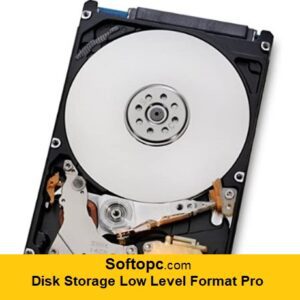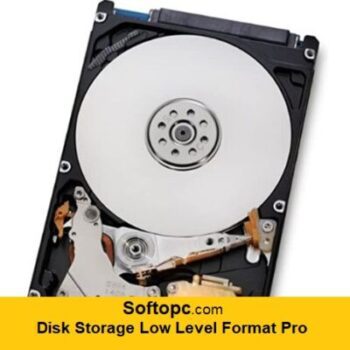Disk Storage Low Level Format Pro Free Download is available for both 32-bit and 64-bit Windows and macOS. You can download the full offline installer standalone setup of Disk Storage Low Level Format Pro for free from Softopc.
Low Level Formatting (LLT) is a powerful Low-Level Formatting application that lets you format a hard drive.
Disk Storage Low Level Format Pro Overview
Disk Storage Low Level Format is a secure Low-Level Formatting program that allows you to format a hard disk using Low-Level Formatting. By concealing the bad sectors on your hard drive to create a clean and error-free surface for your data, it is a convenient program that may restore it. It intelligently restores your storage device to its full capacity by performing zero-fills. After that, it’ll restore your hard drive to its original/factory status, resetting the state and data.
The name of the device, model, firmware version, serial number, device ID, bus type, LBA, and total capacity are among the information provided. SATA, IDE, SCSI, and USB are all supported. Quick Format and Standard Format are two format modes that can be used to reformat storage devices that Windows does not recognize as damaged or broken. The application enables you to make a bootable USB drive or bootable hard drive once formatting is done.
You may boot your storage device into MSDOS, FreeDOS, or Windows with a few clicks. Disk Storage Low-Level Format Pro is a useful program that allows you to erase all data on your hard drive storage devices and reset them using its low-level format method.

Disk Storage Low Level Format Pro Features
After Disk Storage Low Level Format Pro Free Download, you’ll notice a few noteworthy features.
- Low-level Formatting (LLT) is a feature that allows you to format a hard drive.
- To create a clean and error-free surface for your data, hide the bad sectors on infected or corrupted hard drives.
- Zero-fills your storage device then restores it to its full capacity using intelligently.
- The name of the device, model, firmware version, serial number, device ID, bus type, LBA, and total capacity are among the details provided by this tool.
- It has two format modes: Quick Format and Standard Format, which support SATA, IDE, SCSI, and USB.
- Windows has lost or broken the ability to format storage devices that aren’t recognized.
- You may make a bootable USB drive or hard drive with this application.
- With your storage device, you can boot to MS-DOS, FreeDOS, or Windows.
System Requirements for Disk Storage Low Level Format Pro
- Operating System: Windows XP/Vista/7/8/8.1/10/11
- RAM/Memory: 512 MB or more
- Hard Disk(HDD or SSD): 50 MB or more
- Processor: Intel Dual Core or higher processor
FAQ
What is low level drive formatting?
Low level drive formatting is a method of formatting your hard drives that can improve your computer’s performance. Essentially, low level drive formatting cleans up the garbage and temporary files that are used by the operating system and applications. This helps to Speed Up Your Computer and make it more responsive.
How Long Does It Take To Factory Reset A Laptop (Ultimate Guide)
A disadvantage to this approach is that it can delete important files or data, so be sure to back up any important files before proceeding with low level drive formatting. Additionally, keep in mind that this process may not work for all computers, so you should try it out on a small sample of your data first.
If you’re looking to improve your computer’s performance overall, then low level drive formatting could be a helpful tool in achieving your goals. It is important to note, however, that this process may have some negative side effects depending on the circumstances surrounding your computer setup. So if you’re unsure whether or not this approach will work for you, consult an expert first!
How do I low level format an external hard drive?
If you’re looking to low level format an external hard drive, you will need to use the Windows 10 operating system. To do this, first go to Control Panel and search for “File History.” Once File History is open, select the external hard drive that you wish to format and click on the “Formatter” option. On the next screen, check the box next to “Low Level Format” and click on Next. The process can take a few minutes, so be patient!
Once Low Level Formatting is complete, your external hard drive will now be formatted in a way that allows it to be read by other computers. Make sure to back up all of your important files before proceeding!
How can I check if my hard drive has been properly formatted?
Many people think that formatting a hard drive simply restores its default settings and erases all of the data on it. This is not always the case, as formatting can wipe out important files or cause your computer to stop functioning properly. To avoid any potential problems, make sure to do a proper “format” when you first buy a new hard drive or transfer an existing one to a new computer.
To format your hard drive, open the Start menu and type “Format” into the search bar. Then click on Formatting Options on the results page that appears. Under Filesystems (NTFS), select Windows Recovery Environment (RECOVERY) from the list of options and click OK. Next, choose First Time Use for this Installation from the drop-down menu and click OK again. Finally, confirm your selections by clicking the Finish button and starting your computer up normally.
When you format a hard drive using these steps, you will delete all of its contents except system files – which are necessary for operating your computer – rendering it useless as an external storage device.
What are the advantages of using a hybrid hard drive instead of an SSD for storage?
When it comes to storage, there are a lot of options available. Some people prefer using SSDs (solid state drives), while others may prefer hard drives that use a hybrid approach. A hybrid hard drive combines both an SSD and a regular hard drive into one device. The benefits of this approach include faster loading times for web pages and applications, better overall performance, and reduced wear on your computer’s memory or processor due to data fragmentation.
When choosing which HDD/SSD combination is best for you, consider your needs and preferences. If you mainly just need quick access to your files, then an SSD might be the best option for you. However, if you plan on storing lots of movies or music files, then a larger HD might be beneficial. Furthermore, if price is not as much of an issue as performance or longevity is concerned, then buying either type of drive can work just fine.
Disk Storage Low Level Format Pro Free Download
To begin Disk Storage Low Level Format Pro Free Download, simply click the link below. This is a standalone offline installer for Windows Operating System. Both 32- and 64-bit Windows would be compatible with this.
